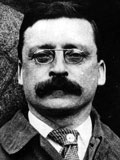A native of Dublin, Arthur Griffith worked as a printer, and joined the Gaelic League and the Irish Republican Brotherhood. In 1896-1898 he worked in the gold mines in South Africa, but returned to Ireland in 1898 to edit the "United Irishman", a weekly newspaper. In 1905 Griffith founded the Sinn Féin ('ourselves'), a nationalist party for achieving independence for Ireland, and became its president. The "United Irishman" ceased publication in 1906 and Griffith started a new paper, "Sinn Féin". He took no part in the 1916 Rising, but the British government imprisoned him for his writings. After his release, Griffith stepped down as Sinn Féin president in favour of Eamon de Valera (October 1917), and in the general election of 1918 Sinn Féin had an overwhelming victory. Griffith retained the East Cavan seat he had won at a by-election earlier that year. He did not participate in the first meetings of Dáil Éireann (21-22 Jan 1919) because he had been imprisoned by the British authorities. He was released and appointed Secretary for Home Affairs (2 Apr 1919 - 9 Jan 1922) in the government of de Valera. While in the United States, President de Valera appointed Griffith deputy president. This appointment was ratified by Dáil Éireann on 17 Jun 1919. Over large parts of the country British rule ceased to operate. Civil resistance was accompanied by guerrilla warfare under the leadership of Michael Collins and Richard Mulcahy. Griffith along with Eóin MacNéill and Eamonn Duggan were arrested by the British on 27 Nov 1920. Griffith was imprisoned in Mountjoy Jail until 30 Jun 1921. Pressure of public opinion led to a Truce in July 1921, and Griffith was chosen to lead the plenipotentiaries to the negotiations that resulted in the Anglo-Irish Treaty of 6 Dec 1921. After a long debate over the Treaty, Dáil approved it by 64 votes to 57. De Valera, who had opposed the Treaty, resigned on 9 Jan 1922. Griffith was elected President in his place. According to the Treaty provisions, on 14 Jan 1922 the pro-Treaty members of the Dáil assembled in Dublin as the Parliament of Southern Ireland. This assembly headed by Griffith and Collins appointed the Provisional Government to serve as a transitional body to whom the British later handed state authority and which functioned along with Dáil departments. In the general election of June 1922 the Treaty party won 58 seats, the anti-Treaty side 36, with the remaining 34 shared by Farmers, Labour, and Independents. The bombardment of the Four Courts held by anti-Treaty forces on 28 Jun 1922 signalled the beginning of Civil War. Griffith died suddenly in Dublin on 12 Aug 1922. Biography source: [6] |

